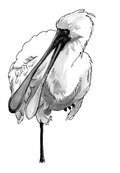异鹮属
| 异鹮属 化石时期:早全新世
| |
|---|---|
| 科学分类 | |
| 界: | 动物界 Animalia |
| 门: | 脊索动物门 Chordata |
| 纲: | 鸟纲 Aves |
| 目: | 鹈形目 Pelecaniformes |
| 科: | 䴉科 Threskiornithidae |
| 亚科: | 朱鹭亚科 Threskiornithinae |
| 属: | †异鹮属 Xenicibis |
| 模式種 | |
| 伴猴异鹮 Xenicibis xympithecus | |

| |
| 异鹮属分布地(红色) | |
异鹮属(学名:Xenicibis)是鹮亚科下的一个已灭绝的属,其唯一已知种伴猴异鹮(Xenicibis xympithecus)[1]也称牙买加鹮(Jamaican ibis)、牙买加不飞鹮(Jamaican flightless ibis)[1]或棒翅鹮(clubbed-wing ibis)[2],棍棒状的翅膀是其独一无二的特征。[3]异鹮属是仅有的两个不会飞的鹮类属之一,另一个属是夏威夷群岛特有的无翼鹮属(Apteribis)。[2][4]
描述
[编辑]1977年,H·E·安东尼(H.E.Anthony)在牙买加长哩洞穴(Long Mile cave)的洞穴沉积物中挖掘出了一些颅后骨骼,并据此对异鹮属进行了首次描述。[1][5]当时,由于其鸟喙骨不完整,它被推测为是不会飞的鸟;后来,牙买加斯旺西洞穴(Swansea Cave)发现了同一物种的肱骨,证实了它不能飞行。[5][6]从包括红山裂缝(Red Hills Fissure)在内的两个新地点发现的新化石表明,异鹮属对腕掌骨进行了独特的改造,[3]使其呈棍棒状。其掌骨扩大并向远端弯曲,侧壁增厚,尺骨和桡骨也进行了调整。异鹮属是大型鹮类,重约2公斤(70盎司)。[3]
棍棒状翅膀的功能
[编辑]鸟类学家推测,异鹮属翅膀是以近似于棍棒或连枷的方式被作为武器使用的,[3]这与一些现生螳螂虾(口足目指虾蛄总科)类似,它们拥有一个棍棒状的远端膨胀的指状物,用来击打猎物和其他虾。[7]然而,在鸟类中,这种适应性似乎是独一无二的。[3]鸟类翅膀对战斗的适应性是一个偶然例子,在这种情况下,不同的鸟类物种会基于周围的实际情况,找到机会使用不同的方法解决同一问题。[3][8]

分布
[编辑]伴猴异鹮是牙买加的特有种,其骨骼已在多个遗迹中均有发现,包括长哩洞穴[1]、斯旺西洞穴[1]、杰克逊湾洞穴(Jackson's Bay Cave)[9]和红山裂缝。[3]来自古巴的声称属于该属的骨头后来被鉴定为秧鹤。[10]牙买加岛和古巴岛从来没有连为一体过,所以不会飞的物种不可能到达不同的岛屿。[5]
参考资料
[编辑]- ^ 1.0 1.1 1.2 1.3 1.4 Olson, Storrs L; Steadman, David W. A new genus of flightless ibis (Threskiornithidae) and other fossil birds from cave deposits in Jamaica. Proceedings of the Biological Society of Washington. 1977, 90 (2): 447–457.
- ^ 2.0 2.1 Tyrberg, Tommy. Holocene avian extinctions. Turvey, Sam (编). Holocene Extinctions. Oxford University Press. 2009: 63–106. ISBN 978-0-19-953509-5.
- ^ 3.0 3.1 3.2 3.3 3.4 3.5 3.6 Longrich, N. R.; Olson, S. L. The bizarre wing of the Jamaican flightless ibis Xenicibis xympithecus: a unique vertebrate adaptation. Proceedings of the Royal Society B: Biological Sciences. 2011, 278: 2333–2337. PMC 3119002
 . PMID 21208965. doi:10.1098/rspb.2010.2117.
. PMID 21208965. doi:10.1098/rspb.2010.2117.
- ^ Olson, Storrs L.; Wetmore, Alexander. Preliminary diagnoses of two extraordinary new genera of birds from Pleistocene deposits in Hawaiian Islands. (PDF). Proceedings of the Biological Society of Washington. 1976, 89: 247–258 [January 7, 2011]. (原始内容 (PDF)存档于2012-03-27).
- ^ 5.0 5.1 5.2 Suárez, William (2001) "Deletion of the flightless ibis Xenicibis from the fossil record of Cuba" 互联网档案馆的存檔,存档日期2011-10-01.. Caribbean Journal of Science 37 (1–2): 109–110
- ^ Olson, Storrs L; Steadman, David W. The humerus of Xenicibis, the extinct flightless ibis of Jamaica. Proceedings of the Biological Society of Washington. 1979, 92: 23–27.
- ^ Patek, S. N.; Korff, W. L.; Caldwell, R. L. Biomechanics: Deadly strike mechanism of a mantis shrimp. Nature. 2004, 428 (6985): 819–20. Bibcode:2004Natur.428..819P. PMID 15103366. doi:10.1038/428819a.
- ^ Gould, Stephen J. Wonderful Life: The Burgess Shale and the Nature of History. New York: W. W. Norton. 1989: 347. ISBN 0-393-02705-8.
- ^ McFarlane, D A; Lundberg, J; Fincham, A G. A late Quaternary paleoecological record from caves of southern Jamaica, West Indies (PDF). Journal of Cave and Karst Studies. August 2002, 64 (2): 117–125 [2022-04-21]. (原始内容 (PDF)存档于2021-12-09).
- ^ Arredondo, Oscar. Sinopsis de las aves halladas en depósitos fosilíferos pleisto-holocénicos de Cuba. Reporte de Investigación del Instituto de Zoología. 1984, 17: 1–3 (西班牙语).




